.jpg)
The new look of Oil and Gas drilling. This is now a high tech discipline dependent upon a wide variety of sensors and controls to extract the resource while protecting the environment.
In the oil and gas industries, the use of fluid sensing has become more and more critical. Water, chemical solutions, and oils play crucial roles in the lifecycles of wells and are significant in unconventional and innovative drilling techniques such as fracking.
The development of innovative techniques and regulations means that monitoring of various chemicals in backflows and wastewater is essential. This shows that liquid level sensing is currently required for more than just performance monitoring; oil and gas operators must make sure that they are vigorously taking protective measures against environmental damage through the effective collection, storage, and treatment of wastewater. These steps can be executed reliably and efficiently using liquid level sensing.
.jpg)
General applications of liquid level sensing include monitoring the level of storage tanks, tote level monitoring, chemical injections, monitoring reservoirs of lubricating and hydraulic fluids, and monitoring drilling fluid (“mud”) tanks.
Produced Water Monitoring with Reliable Level Sensors
Although fracking now lies outside the Clean Water Act, pressure from environmental groups means that drilling companies will have to still regulate their contaminant outflows and water use.
Fracking can give rise to the leakage of various different toxic substances. Based on the location of the operation and size, there may be a need to treat water on-site, and any contaminated water should be transported off-site for successive treatment. Before treating, contaminated water tends to be stored on-site in both cases. Typical chemicals present in the water are:
- 1,2-ethanediol (ethylene glycol)
- Isopropanol
- 2-butoxyethanol (ethylene glycol monobutyl ether)
- Methanol
- Sodium hydroxide (caustic soda)
- Hydrotreated light petroleum distillates
It is necessary for effective monitoring to involve the collection, treatment, and removal of these toxic compounds on a regular basis as part of the production process. Reliable liquid level sensing is the main component in realizing this.
Failure to follow these steps could prove costly. Following legal action by the environment protection agency, Exxon paid a fine of $100K, with an extra $20M paid to prevent wastewater contamination from drilling in Pennsylvania and West Virginia. The spill in question was detected by inspectors, who found out that fracking wastewater flowed from their storage wells through an open valve.
Improved sensing technologies that detect any drops in well levels would have prevented the wastewater (containing chloride, barium, and strontium) from leaking. Exxon is required to establish a continual, remote-monitoring liquid level sensing system for all of its production sites as a consequence of this legal and environmental fallout. This system will trigger alarms if a leakage occurs, enabling all of the interconnected tanks to be monitored.
.jpg)
In a similar instance that also occurred in Pennsylvania, unmonitored systems led to the spill of toxic fluids from fracking. In one instance, 227,000 gallons of fluid were split, leading to a large-scale evacuation, and in another, 9000 gallons contaminated a farm.
In the oil and gas industry, execution of optimal practices increases the confidence of the public that the environment is being protected and that drinking water is safe. The EPA suggests using liquid level monitoring to prevent wastewater spills. This monitoring should be performed using reliable and accurate level sensors.
.jpg)
Sample of Gems Level Sensors in Oil and Gas
.jpg)
Single-point level switches
.jpg)
Multi-point level switches
.jpg)
Tank gauging level indicators
.jpg)
Continuous level transmitters
Gems Sensors can offer a significant service in this field, by helping the oil and gas industry make their operations safer. For over half a century, Gem Sensors have offered tailored solutions to the oil and gas industry, which enables them to measure the pressure, flow, and levels in their systems.

This information has been sourced, reviewed and adapted from materials provided by Gems Sensors and Controls.
For more information on this source, please visit Gems Sensors and Controls.